If you haven’t already taken the plunge and kitted out an area of your home for recording, you may be wondering where to start. That’s understandable; if you’ve ever been to a professional studio, you’ll know they can be a treasure trove of bespoke studio furniture, more wires and cables than you’ve ever seen before, and vast collections of rare, vintage and top-tier equipment. Don’t worry. For the average home studio user, there are steps you can take to put you on the right track.
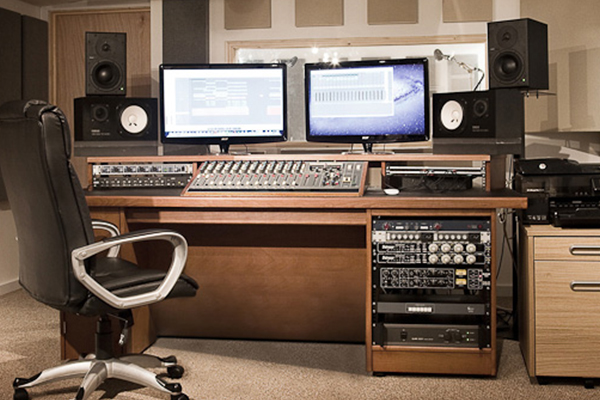
In this guide, we’ll offer some advice on how to get started with your home recording studio, from the right types of recording studio furniture you’ll need to make life easy through to some tips on how to layout your space to get the best results. We’re not going to focus too much on actual production gear like recording devices or instruments; that’s another conversation for another day. This is more about getting the foundations down for you to have a place you and your music can call home. Let’s begin.
Why build a home recording studio?
It’s reasonable to ask why you need a dedicated music production studio. Picture the scene, if you will. If you’re anything like us, you’ll have probably spent time huddled over a laptop-based Ableton Live session and have the crooked back to show for it. Imagine a world, however, where you needn’t hunch. You need never hunt for a space to work in, and you won’t have to share with your kids/partner/dog.
There are a lot of ‘side’ advantages to having a space to call your own, but primarily it all comes down to giving you the best environment possible with which to hone your craft. A place where your external synths, samplers and drum machines are permanently installed, ready to be switched on and played. A place where you have a set of drawers dedicated to storing cables of all kinds. A place where your sole focus is to make music.
Best of all, you don’t necessarily need a lot of space, either. It may be a corner of your bedroom, or the shed at the end of the garden, or even the cupboard under the stairs. What’s important, however, is to ring-fence that area and let it be known, from this day forward, that this shall be your studio space.
Home studio setup
In an ideal world, your studio would be stocked full of all the gear you’ve ever dreamed of, with a custom studio desk carved immaculately to the nearest millimetre, and an espresso machine. Got to have your coffee, right? Realistically, however, we all have to start somewhere, and if you’re new to home studios then we’d strongly advise your first consideration be a dedicated music production desk.
A studio desk doesn’t necessarily need to be large, but it helps to have certain features built in which make your life easier. This could be space for outboard rack equipment, or it could be ergonomically shaped to ‘wrap around’ your seating position. It may even be as simple as having built-in stands on which you can put your studio monitor speakers.
For many people, a desk may have to serve multiple purposes. With more people working from home now, it makes sense that, by day, your desk may be used for things other than music production. Keep in mind the overall requirements you have, and plan accordingly.
Regardless of the desk’s intended use, size is important. One thing you can be sure of is that as you progress as a producer or performer, your arsenal of musical equipment will grow. We’ve seen many people outgrow their studio desks within a short period of time which means either shedding precious music gear or upsizing the desk. Best to go as large as you can afford – or as large as your space allows – from the start.
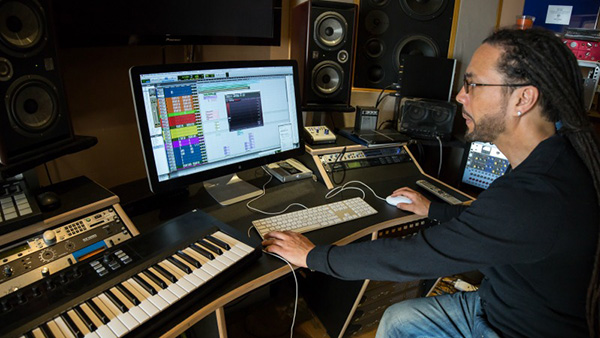
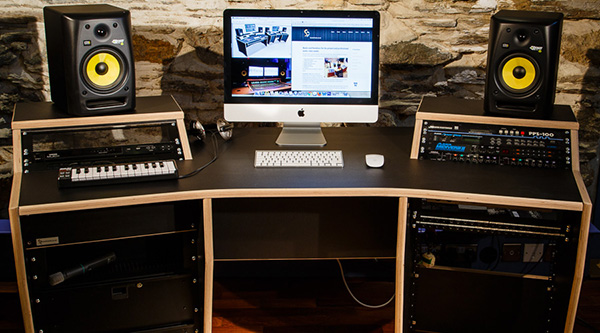
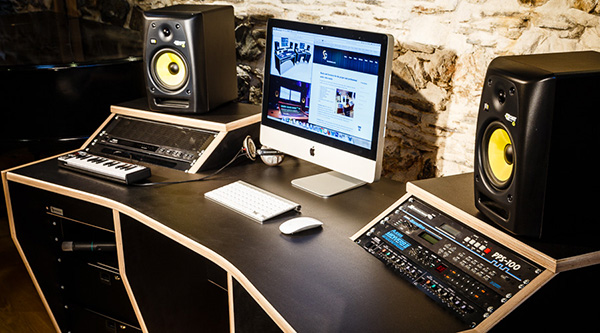
Setting up your home recording studio
With a dedicated desk in your home music studio, the process begins to get everything set up the way you want it. This, we promise, is the fun part, however, it can throw up some minor issues. Our advice here is to forget about wires, plugs and connections for now, and place your hardware in the location you envisage it will work best for you.
A fairly standard desk will have the computer screen – either monitor or laptop – located in front of you, with the centre of the screen raised to be at eye level. Either side of the monitor you’ll place your monitor speakers, again raised to be level with your ears. This setup is common for the simple reason it makes the most sense; your eyes look forward and your ears benefit from a genuine stereo field from the speakers.
The remaining available space is down to you; your own rig may comprise MIDI keyboards, control surfaces or modular equipment. Try to picture what your ideal workflow will be, and arrange your equipment to suit this.
With everything in place, you now can start making those connections. If there’s any part of this process that has the potential to annoy, it is this. Those battered old cables and wires you’ve used for years may have been fine before when everything was more transient, but with a dedicated studio space, there’s a strong argument for installing everything with a degree of permanence. Good quality audio leads aren’t expensive, and fitting things with the right length of cable means you can avoid unsightly wire-spaghetti everywhere. Plus, it just looks more professional, which is no bad thing.
If you use rack effects, compressors or other outboard equipment, it’s worth investigating dedicated 19 inch rack. These can be freestanding or integrated into your desk, and provide a secure place to house your gear. Our Rack Pod is a great option for placing directly on top of a desk or, if you have lots of rack units, you will appreciate the extra space afforded by our Trolley Rack.
Another thing to consider is acoustic treatment. Essentially, this relates to setting your space up so it sounds as good as it can. Rooms inherently have a sound, based on various factors including the shape and size, the type of flooring used, and even the paint on the walls. In truth, this is a subject which deserves further reading to extract all the benefits, but as a basic set of principles, you want to try and set the room up so there is as little standing in the way of those beautiful waves of sounding coming from the speakers reaching your ears without being shaped by the make-up of the room.
Bass, for example, is heavily influenced by surfaces and walls, so placing your speakers slightly off the desk using acoustic foam can significantly improve your mixes. Likewise, having your studio in the corner of a room can make the sound you’re hearing appear lopsided. There are many solutions to give you the best shot at room correction, from foam tiles placed on walls through to creating mini vocal or guitar amp booths using old duvets or bedsheets. Identify the potential troubles you may come across in your particular niche, and be creative with your solutions. It’s your studio, after all.
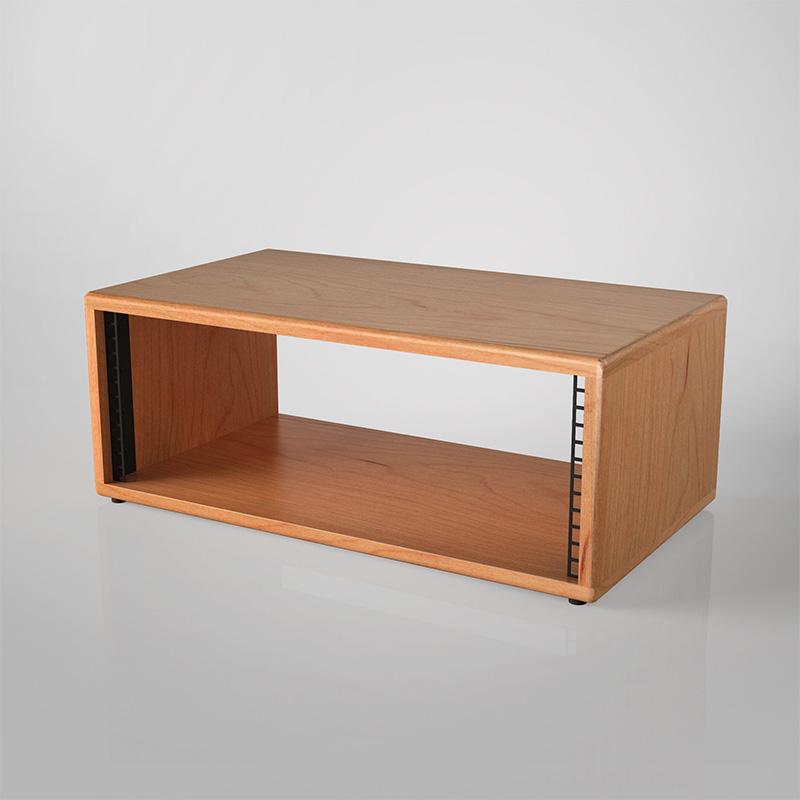
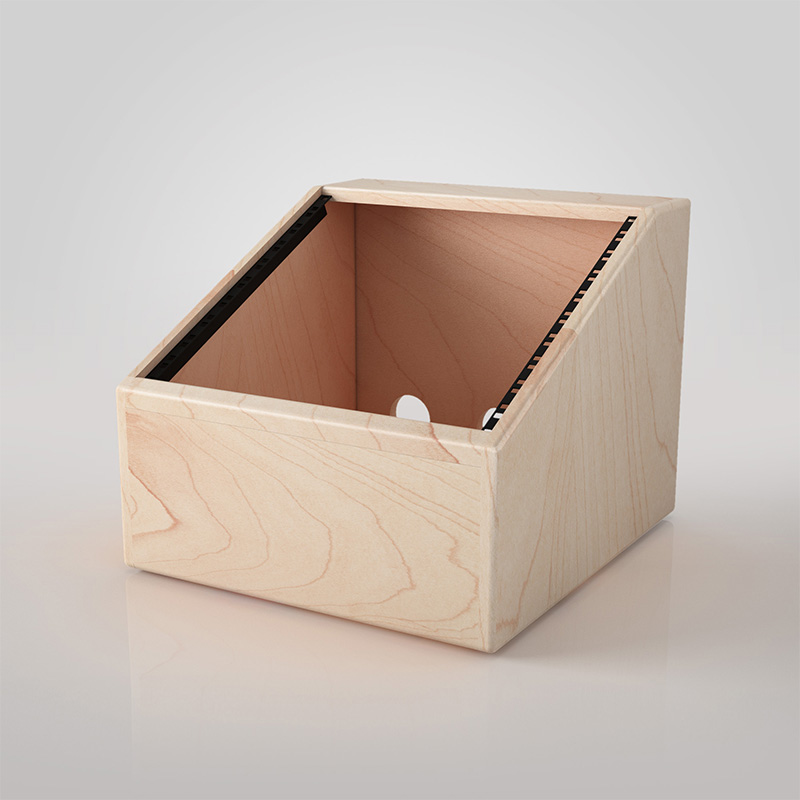
Benefits of a dedicated home recording studio
As we touched on earlier in the article, the major benefit to having a space dedicated to home recording comes in your workflow. With enough room to operate, and everything connected up as it should be, your new workflow should be as simple as turning everything on and hitting record. No more searching for that XLR cable you last saw a month ago, and no more swapping out synths every time you need a specific sound.
There’s also a lot to be said for the old ‘tidy desk, tidy mind’ philosophy. Knowing you’re sitting down in a studio – your studio – to work on music, and only music, is an incredible motivator and you will hopefully enjoy a new lease of life creatively.
Conclusion
If there’s one piece of advice you take away from this article, it should be that having a home recording studio space dedicated purely to home recording takes away a multitude of reasons not to work on music. If you’ve spent time with your music space doubling up as your ‘regular’ work desk, or a kitchen table, then you’ll know how demotivating it can be to switch between the different personas. Setting up an environment specifically for your music might just be the thing that kick-starts your musical career. You can thank us later!
